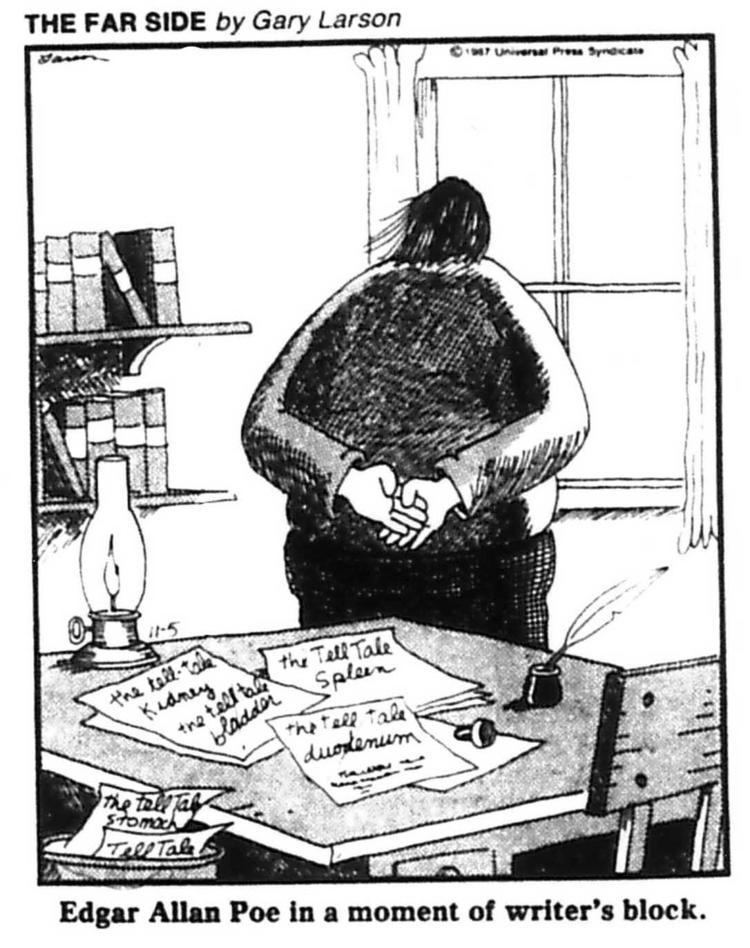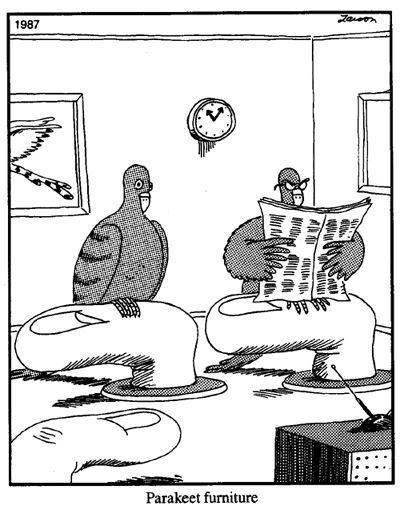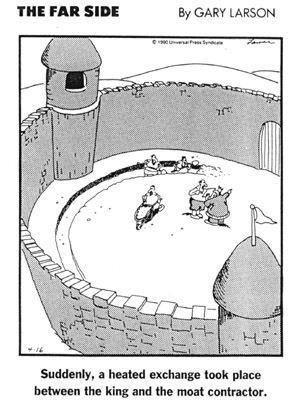Current status / schedule Ended Preceded by Nature's Way End date January 1, 1995 | Launch date January 1, 1980 | |
 | ||
Genre(s) Humor, satire, avant-garde Similar | ||
The far side 1986 gary larson interview on 20 20
The Far Side is a single-panel comic created by Gary Larson and syndicated by Universal Press Syndicate, which ran from January 1, 1980, to January 1, 1995. Its surrealistic humor is often based on uncomfortable social situations, improbable events, an anthropomorphic view of the world, logical fallacies, impending bizarre disasters, (often twisted) references to proverbs, or the search for meaning in life. Larson's frequent use of animals and nature in the comic is popularly attributed to his background in biology. Reruns are still printed in many newspapers.
Contents
- The far side 1986 gary larson interview on 20 20
- Kerry uchida sound design demo tales from the far side 1 2
- Design overview
- Publications
- Collections
- Other books
- On television
- Online
- Displays
- References

The Far Side was ultimately carried by more than 1,900 daily newspapers, translated into 17 languages, and collected into calendars and 23 compilation books.

The series was preceded by a similar panel called Nature's Way, also by Larson.
Kerry uchida sound design demo tales from the far side 1 2
Design overview
Most The Far Side cartoons are a single rectangular panel, occasionally split into small sections of four, six, or eight for the purposes of a storyline. A caption or dialogue usually appears under the panel as typed text, although word-balloons are sometimes used for conversations. Sunday comics were double-sized, done in watercolor or colored pencils, with captions handwritten in Larson's own hand. Most of Larson's comics relied on some combination of a visual and verbal gag, rather than just one or the other. Some recurring themes in the comic include people being stranded on desert islands, aliens, heaven, hell, and the life of cavemen. Many cartoons focused on animals, especially cows, bears, dogs, flies, and ducks. Notably, virtually all characters portrayed in the comic were overweight or obese, and usually wearing glasses. In addition, unless needed for a facial or comic expression, eyes are almost never drawn and characters usually show only a brow ridge.

Larson was recognized for his work on the strip with the National Cartoonist Society Newspaper Panel Cartoon Award for 1985 and 1988, and with their Reuben Award for 1990 and 1994.

The Complete Far Side and The Prehistory of The Far Side include letters from angry readers alongside the comics. The letters were written to newspaper publishers and often demanded the removal of The Far Side. Despite these protests, The Far Side remained popular and continued to run in many newspapers. Larson himself often laughs at the controversies as evidenced in The Prehistory of The Far Side, in which he writes that the people complaining have usually misunderstood the cartoon.
Publications
Gary Larson produced 23 The Far Side books, which were all on The New York Times Best Seller list. The cartoons were first collected in small books (see list below), and some were then republished in larger best-of collections such as The Far Side Galleries. Additional best-of collections were published, such as The Prehistory of The Far Side, culminating in the final publication, The Complete Far Side in 2003.
Collections
Other books
The five The Far Side Gallery books are the most popular, each of them collecting together the best cartoons from three smaller books, along with a humorous foreword by celebrity fans, including Stephen Jay Gould, Stephen King, Robin Williams, and Jane Goodall.
In 1989, The Prehistory of The Far Side was published to celebrate the tenth anniversary of the strip. In this book, Gary Larson discussed the development of The Far Side, and the public's reaction to it, and presented a selection of his personal favorites from the cartoon's history as well as previously unpublished sketches and strips rejected by his editor.
In 2003, The Complete Far Side was released, containing nearly every The Far Side comic ever published (except for a few cartoons written for Christmas cards). The collection is also missing parody art pieces from Wiener Dog Art, some material from The Prehistory of The Far Side, and a panel run for a caption writing contest in the Telegram-Tribune newspaper. The set was released in two volumes (1980–1986 and 1987–1994) with a foreword by Steve Martin and an introduction by Larson's longtime editor, Jake Morrisey. The first-edition hardcover boxed set weighs 19.5 pounds (8.8 kg). Some of the comics were altered for this book, either featuring a different caption, correcting errors, or simply becoming colorized.
In 2003, Gary Larson drew a cover for the November 17 edition of The New Yorker magazine, a prestigious offer he said he could not refuse.
On television
In 1994, Larson produced an animated special, Tales from the Far Side, featuring his art style and gags from the strips. He produced a sequel in 1997.
Online
Larson has persuaded people not to use Far Side cartoons on the internet, writing a widely distributed letter in which he explains the "emotional cost" to him of people displaying his cartoons on their websites and asks them to stop doing so.
Displays
In 1987, a special exhibit of 527 black and white Far Side panels was shown in the Smithsonian Institution's National Museum of Natural History in Washington D.C. One hundred twenty-seven of the panels were originals, displayed in the rotunda on boards that held fifty panels each. Later the display became a traveling exhibit that was shown in San Francisco, Washington D.C., Orlando, Chicago, Toronto, New York City, Denver, and Los Angeles.
There was a Far Side gallery at the California Academy of Science that featured some of Larson's panels. The exhibit included a giant microscope under which visitors could stand, based on one of Larson's cartoons. Looking up through the objective lens revealed a giant blinking eyeball. The building was torn down and replaced and the exhibit is no longer in the new facility.
